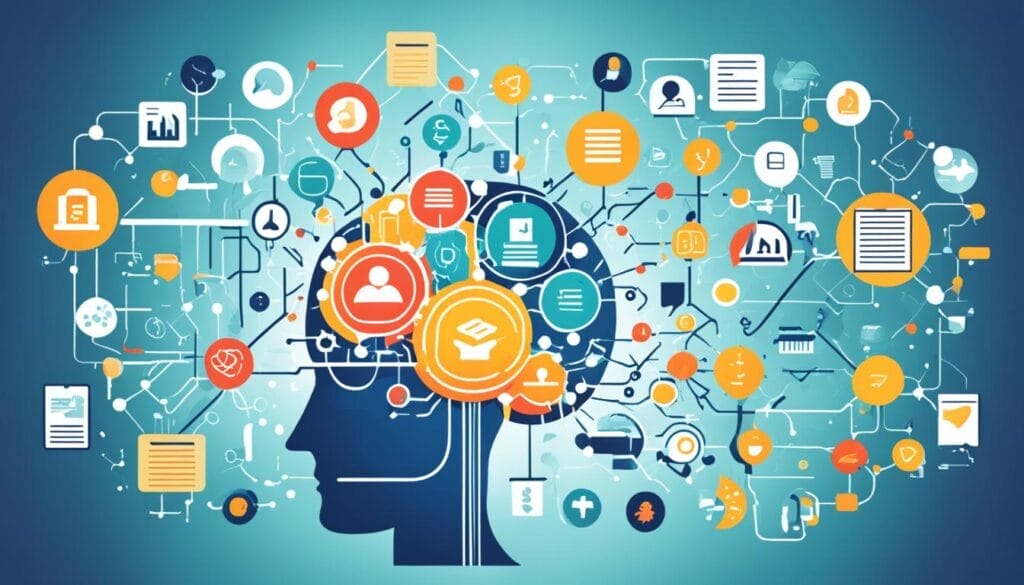“Education is not the filling of a pail, but the lighting of a fire.” – William Butler Yeats
AI has emerged as a powerful tool in the realm of education, transforming the way we design learning paths and revolutionizing personalized learning. With the rise of adaptive learning and the increasing demand for tailored educational experiences, AI-powered learning paths are paving the way for a new era of effective and engaging learning.
By harnessing the potential of AI, educators and instructional designers can create personalized learning paths that cater to the unique needs, interests, and learning styles of individual learners. This innovative approach not only enhances the effectiveness of education but also maximizes the potential of each learner, igniting their passion for lifelong learning.
Key Takeaways:
- AI-powered learning paths offer personalized and adaptive learning experiences.
- AI utilizes data analytics to track learner progress and customize training content.
- AI-powered learning paths enhance engagement, efficiency, and effectiveness in education.
- Personalized learning paths cater to the unique needs and interests of individual learners.
- AI-powered learning paths ignite a passion for lifelong learning.
The Role of AI in Personalized Learning
AI-driven personalized learning is revolutionizing the education sector by utilizing AI algorithms and machine learning capabilities to create customized learning pathways for individuals. By analyzing learner data, such as performance, preferences, and learning pace, AI can tailor curriculum content and provide a personalized learning experience.
One of the key advantages of AI-driven personalized learning is its ability to generate customized content that meets the specific needs of each learner. Whether it’s adjusting the difficulty level of a lesson or providing additional resources based on individual progress, AI ensures that learners receive the right content at the right time.
In addition, AI plays a crucial role in recommending personalized learning plans to individuals. AI algorithms consider various factors, such as the learner’s interests, goals, and preferred learning style, to suggest a personalized path that optimizes the learning experience.
AI-driven personalized learning offers a transformative approach to education, enriching the learning journey with adaptive, interactive, and tailored experiences.
Furthermore, AI enables instant feedback and assessment, making the learning process more efficient and effective. Learners can receive immediate feedback on their performance, allowing them to identify areas for improvement and make necessary adjustments.
Natural language processing is another key feature of AI in personalized learning. With AI-powered interactive learning experiences, learners can engage in conversations with virtual instructors or chatbots, enhancing their understanding and retention of the material.
AI also plays a crucial role in making learning materials more accessible and inclusive. Through AI-powered technologies, content can be adapted to accommodate different learning needs, ensuring that every learner has equal opportunities for success.
Intelligent Learning Journeys
Moreover, AI-driven personalized learning facilitates lifelong learning and professional development. It enables learners to embark on intelligent learning journeys that adapt to their evolving needs and career aspirations.
By leveraging the power of machine learning and data analytics, AI ensures that personalized learning is not only effective but also cost-effective. Organizations can optimize their training budgets by providing targeted and customized learning experiences, maximizing their return on investment.
In conclusion, AI-driven personalized learning is transforming the education landscape by providing tailored learning experiences that cater to the unique needs of each individual. With AI as a powerful ally, learners can embark on intelligent learning journeys that enhance their knowledge, skills, and career prospects.
How to Personalize Learning with AI
Personalizing learning with AI powered-tools can revolutionize the learning experience by tailoring it to each individual’s needs. With the help of AI, educators can create a more engaging and effective learning environment. Here are some key steps to personalize learning with AI:
- Define clear learning objectives and goals: Clearly define the desired outcomes for each learner, ensuring alignment with organizational objectives.
- Identify individual learning needs: Analyze learner data to understand their strengths, weaknesses, and preferred learning styles. This allows for personalized content and support.
- Select AI-powered tools or platforms: Choose AI-powered learning platforms or tools that can adapt to individual needs and provide personalized learning experiences.
- Develop or curate content: Create or gather content that can be adjusted based on learners’ abilities and progress. Make use of AI to recommend relevant resources.
- Offer AI-enabled instant feedback and recommendations: Leverage AI to provide timely feedback and recommendations to learners, aiding their learning process.
- Track learner progress and suggest when to move on or review: Monitor learner progress using AI-powered analytics and suggest appropriate next steps based on their performance.
- Facilitate collaborative learning: Encourage collaboration and knowledge sharing among learners by incorporating collaborative learning techniques and AI-supported group activities.
- Monitor performance and engagement: Use learning analytics to track learner engagement and performance, identifying areas for improvement.
- Seek feedback from learners and trainers: Actively seek feedback from learners and trainers to continuously improve the personalized learning experience.
- Continuously assess and improve: Regularly evaluate and refine the personalized learning program based on data-driven insights, refining the learning experience to optimize outcomes.
By combining AI, personalized learning, adaptive assessments, collaborative learning, and learning analytics, educators can create a truly customized learning experience that caters to the unique needs of each learner.
The Advantages of AI in Personalized Learning
AI-powered personalized learning brings numerous advantages to learners and organizations alike. Through its intelligent capabilities, AI enhances the learning experience and drives improved outcomes. Here are some of the key advantages:
Improved Learning Outcomes
AI personalizes learning experiences, ensuring that the content and delivery cater to each individual’s unique needs. By adapting to learners’ preferences, AI optimizes the learning process, resulting in better retention, comprehension, and overall performance.
Scalability
AI enables scalable training by automating certain tasks, such as content generation, assessment, and feedback. This allows organizations to efficiently cater to a large number of learners simultaneously, without compromising the quality of personalized learning experiences.
Cost-Effective Training
Implementing AI-powered personalized learning can lead to significant cost savings. By automating labor-intensive tasks, reducing the need for manual intervention, and optimizing resource allocation, organizations can provide high-quality training at a lower cost.
Data-Driven Decision Making
AI leverages data analytics to provide valuable insights for decision making. By analyzing learner data, organizations can make informed choices about curriculum design, content customization, and instructional strategies, ensuring continuous improvement and effectiveness.
Customized Career Development
AI empowers learners to design their own career development paths. By analyzing individual strengths, weaknesses, and career aspirations, AI helps create personalized learning journeys that align with learners’ career goals, improving their chances of success in their chosen fields.
Enhanced Accessibility and Inclusivity
AI assists in making learning more accessible for individuals with disabilities. By providing customized learning tools, adaptive assessments, and support for diverse learning styles, AI ensures that individuals of all abilities can engage in personalized learning experiences.
Promotion of a Continuous Learning Culture
AI supports a continuous learning culture by providing ongoing learning opportunities tailored to learners’ needs and preferences. By encouraging self-paced learning, AI helps individuals foster a mindset of continuous growth and development.
Gaining a Competitive Advantage
Organizations that embrace AI in personalized learning gain a competitive edge in today’s rapidly changing business landscape. By leveraging the power of AI, they can develop agile and adaptable employees who can stay ahead of the curve and drive innovation.
With these advantages, AI-powered personalized learning revolutionizes traditional approaches to training and development, paving the way for more effective, efficient, and engaging learning experiences.
The 5 Pillars of Personalized Learning with AI-Powered LMS/LXP
AI-powered tools such as Learning Management Systems (LMSs) and Learning Experience Platforms (LXPs) play a crucial role in personalized learning.
- Understanding Baseline Proficiency: By utilizing knowledge checks and assessments, AI-powered LMS and LXPs evaluate the learner’s existing knowledge and skills, establishing a baseline proficiency level.
- Recommending Content: Based on the learner’s individual performance and interests, AI-powered platforms recommend relevant and personalized learning materials, including articles, videos, interactive modules, and more.
- Creating Learning Paths: With AI, personalized learning paths are designed to cater to the specific needs and goals of each learner. These paths map out the sequence of learning content, ensuring a targeted and optimized learning journey.
- Providing Proactive Assistance: Virtual assistants and chatbots powered by AI are available to provide proactive assistance throughout the learning process. Learners can receive instant support, answers to their questions, and guidance whenever they need it.
- Sharing Feedback: AI-powered LMS and LXPs enable continuous monitoring and feedback. Learners receive meaningful feedback on their progress and areas for improvement, allowing them to overcome weaknesses and strive for continuous growth.
These five pillars empower learners to engage in personalized learning experiences that cater to their unique needs, interests, and goals. AI-driven adaptive learning platforms analyze learner data, ensuring the delivery of personalized learning pathways, resources, and activities that are tailored to each individual’s requirements.
By leveraging the power of AI in personalized learning, learners can access the support and resources they need to succeed in their educational journey.
The Process of Implementing Personalized Learning Using AI
Implementing personalized learning using AI requires careful planning and collaboration. Here is a step-by-step process to help you successfully implement personalized learning with AI:
- Clarify Goals: Start by defining clear goals for your personalized learning initiative. Determine what outcomes you want to achieve and how AI can support those goals.
- Understand Learners’ Needs: Conduct a thorough analysis of your learners’ needs, preferences, and learning styles. This will help you tailor the personalized learning experience to their individual requirements.
- Select AI Platforms: Research and select AI platforms that align with your business goals and meet your learners’ needs. Look for platforms that offer features such as adaptive assessments, personalized content recommendations, and progress tracking.
- Develop Adaptable Content: Create or curate content that can be easily adapted based on learners’ abilities and progress. The content should be flexible enough to support personalized learning pathways.
- Conduct Pilot Testing: Before fully implementing personalized learning with AI, conduct pilot testing with a small group of learners. This will help you identify any challenges or areas for improvement.
- Train AI Models: Train AI models using learner data to personalize the learning experience. Ensure that the AI models are properly trained and calibrated to provide accurate recommendations and feedback.
- Personalize Parameters: Adjust the parameters of the AI algorithms to ensure that the recommendations and feedback provided align with the desired personalized learning experience.
- Seek Feedback: Regularly seek feedback from learners and trainers to understand their experience with personalized learning. Use this feedback to make necessary adjustments and improvements.
- Monitor Learner Progress: Continuously monitor learner progress using AI-driven analytics. Track their performance, engagement, and areas for improvement to provide timely support and interventions.
- Use Adaptive Assessments: Employ adaptive assessments that adjust difficulty based on learners’ responses. This ensures that the assessments accurately reflect their knowledge and progress level.
- Ensure Data Privacy and Security: Implement measures to protect learner data privacy and ensure the security of AI platforms. Comply with applicable data protection regulations and industry best practices.
- Continuously Assess and Improve: Regularly evaluate the effectiveness of your personalized learning program and make necessary adjustments based on learner feedback and outcomes. Continuously improve the program to meet evolving needs.
By following this process, you can successfully implement personalized learning using AI and create a more effective and engaging learning experience for your learners.
The Integration of AI and Instructional Design

The integration of AI and instructional design has revolutionized traditional teaching methodologies, reshaping the way educators approach personalized learning paths and enhancing student engagement. By harnessing the power of AI algorithms and machine learning capabilities, instructional designers are able to create tailored lesson sequences, adaptive learning systems, and real-time feedback mechanisms that cater to each student’s unique needs.
AI analyzes individual learner data, such as performance and learning preferences, to develop personalized learning paths that optimize the learning experience. It enables interactive games and simulations that adapt to learners’ progress, making the learning process more engaging and immersive.
“AI-equipped systems have the potential to transform instructional design by streamlining research, curriculum development, course design, and content creation processes.”
Furthermore, the integration of AI streamlines various aspects of instructional design, enhancing productivity and ensuring high-quality educational materials. With AI-driven tools, instructional designers can automate research, analyze learner data, and generate personalized content, all of which contribute to a more efficient and effective curriculum development workflow.
Overall, the integration of AI and instructional design not only improves personalized learning experiences but also enables educators to optimize their teaching methodologies, resulting in enhanced engagement and better educational outcomes.
Benefits of AI and Instructional Design Integration:
- Personalized learning paths tailored to individual student needs
- Adaptive learning systems that adjust content based on student performance and progress
- Real-time feedback mechanisms for immediate assessment and improvement
- Engaging interactive games and simulations that adapt to student progress
- Streamlined research, curriculum development, course design, and content creation processes
Example of AI and Instructional Design Integration:
| AI Application | Example |
|---|---|
| Intelligent Tutoring System | Carnegie Learning’s AI-powered tutoring system provides personalized feedback and guidance to students, adapting to their individual learning needs. |
| Virtual Reality Simulations | Spatialand’s VR simulations utilize AI algorithms to create immersive learning experiences that adapt to student performance and engagement levels. |
| Content Creation Automation | Articoolo’s AI-powered platform generates high-quality, tailored content for instructional materials, saving instructional designers time and effort. |
Optimizing Content Development Workflow with AI
The incorporation of AI in the content development workflow can greatly optimize the process for instructional designers. AI tools provide valuable assistance in various stages, from research and brainstorming to curriculum development, course design, and content creation.
When it comes to research and brainstorming, AI can transcribe and analyze subject matter expert interviews, saving time and effort. These tools are capable of summarizing content, automating content gathering, and even proposing ideas for structure and interactive elements.
In curriculum development, AI streamlines the process by analyzing data sets and identifying learner requirements. It can generate suitable learning objectives based on learner profiles and preferences, ensuring the content is tailored to their needs.
When designing a course, AI plays a crucial role in aligning content with learning objectives. It suggests course flow and organization, ensuring a coherent and optimized learning experience. Additionally, AI can automate assessments, making the process more efficient and consistent.
Content creation can be time-consuming, but with AI, it becomes faster and more efficient. AI tools can generate draft content, curate relevant materials, and provide assistance with multimedia elements such as images and videos. This allows instructional designers to focus on the creative aspects of content development while relying on AI for support.
| AI Benefits in Content Development Workflow | Description |
|---|---|
| Research and Brainstorming | Transcribe, analyze interviews; summarize content; automate content gathering; propose structure and interactive ideas. |
| Curriculum Development | Analyze data; identify learner requirements; generate suitable learning objectives. |
| Course Design | Align content with learning objectives; suggest course flow; automate assessments. |
| Content Creation | Generate drafts; curate content; provide assistance with multimedia elements. |
By incorporating AI into the content development workflow, instructional designers can streamline processes, save time, and enhance the overall quality of the learning materials.
As AI continues to advance, it will undoubtedly play an even more significant role in optimizing the content development workflow. Instructional designers can leverage AI tools to accelerate research, generate valuable insights, and enhance the overall effectiveness of learning experiences.
Ensuring Accessibility for Learners with AI

AI tools have become indispensable in ensuring accessibility in education. These tools leverage the power of artificial intelligence to address the diverse needs of learners and create an inclusive learning environment. Through a range of capabilities, AI tools play a vital role in making educational content accessible to all.
Automatic Caption Generation and Transcription
One of the key features of AI tools is their ability to automatically generate captions for videos and transcribe audio content. This functionality enables learners with hearing impairments to access multimedia content effectively. By providing accurate and timely captions, AI tools eliminate barriers and ensure equal opportunities for all learners.
Language Translations for Inclusive Education
AI tools also support inclusive education by providing language translations. Language barriers can hinder learning, especially for non-native English speakers. AI-powered translation tools enable learners to access educational materials in their preferred language, ensuring they can fully engage with the content and participate actively in the learning process.
Inclusive and Compliant Educational Materials
AI tools assist in creating inclusive and compliant educational materials. They analyze content and suggest modifications to ensure compliance with accessibility guidelines, such as making text readable for screen readers and optimizing visual elements for learners with visual impairments. By incorporating AI tools, instructional designers can create accessible materials that cater to the diverse needs of learners.
Feedback Analysis and Project Management
AI tools facilitate feedback analysis and project management in educational settings. They can analyze feedback provided by learners and identify areas for improvement in accessibility. Additionally, AI tools streamline project management processes, helping instructional designers effectively track progress, collaborate with team members, and ensure compliance with accessibility standards.
Version Control for Accessibility
Version control is another area where AI tools contribute to ensuring accessibility. They assist instructional designers in managing different versions of educational content, allowing for easy updates and modification to meet evolving accessibility requirements. With version control, accessibility enhancements can be implemented efficiently, ensuring content remains inclusive and up to date.
Instructional designers have a responsibility to make education accessible to all learners and comply with accessibility laws and guidelines. By leveraging AI tools, they can create content that is inclusive, engaging, and impactful for learners with diverse abilities. Together, AI and instructional design enable a more accessible and inclusive learning environment.
Examples of AI-Led Curriculum Ideas
AI is revolutionizing curriculum design with various examples of AI-led curriculum ideas. Personalized learning platforms like Khan Academy and Duolingo adapt to individual learner progress, providing tailored content and assessments. Intelligent tutoring systems such as Carnegie Learning and Thinkster Math act as virtual tutors, offering customized feedback and guidance to students. Adaptive assessments like ALEKS adjust difficulty based on learner responses, ensuring a personalized testing experience.
Language learning apps like Babbel and Rosetta Stone utilize AI to personalize lessons based on learner patterns, making language acquisition more efficient and engaging. Virtual labs and simulations, such as Labster, offer immersive learning experiences in various subjects, allowing students to apply their knowledge and skills in a virtual environment.
These AI-led curriculum ideas enhance engagement, provide personalized learning experiences, and improve educational outcomes. By leveraging the capabilities of AI, students can have tailored learning experiences that cater to their individual needs and preferences.
AI-powered personalized learning platforms, intelligent tutoring systems, adaptive assessments, language learning apps, and virtual labs and simulations are just a few examples of how AI is transforming education and enhancing the learning experience. With the integration of AI, education becomes more personalized, adaptive, and effective, fostering the development of lifelong learners.
Conclusion
The integration of AI in education has revolutionized the field of instructional design and personalized learning paths. AI-powered tools and platforms have significantly optimized the learning experience, making it more tailored and effective for learners. By leveraging AI, content can be personalized, assessments can be adapted, engagement can be enhanced through interactive elements, and immersive simulations can be created.
Instructional design has also benefited from the integration of AI. The content development workflow has become more productive and efficient, thanks to AI’s ability to streamline processes and provide valuable insights. However, it’s crucial to consider ethical considerations such as data privacy, accessibility, and biases in AI algorithms as we move forward.
The future of education lies in the successful integration of AI and instructional design to create personalized and inclusive learning experiences. By leveraging AI technologies, education can become more accessible, engaging, and effective for learners of all backgrounds. It’s an exciting time for AI in education, and the possibilities for personalized learning paths and instructional design are vast.
FAQ
What are AI-powered learning paths?
AI-powered learning paths are personalized learning journeys that utilize artificial intelligence algorithms and machine learning capabilities to create customized learning pathways for individuals. These paths analyze learner data to tailor curriculum content, provide recommendations, and offer personalized learning experiences.
How does AI personalize learning?
AI personalizes learning by analyzing learner data such as performance, preferences, and learning pace. It uses this data to tailor curriculum content, provide customized learning paths, offer instant feedback and recommendations, and create interactive learning experiences. AI also helps in making learning materials more accessible and inclusive.
What are the advantages of using AI in personalized learning?
Using AI in personalized learning offers several advantages, including improved learning outcomes, scalability, cost-effective training, data-driven decision making, customized career development, enhanced accessibility and inclusivity, and promotion of a continuous learning culture.
What are the pillars of personalized learning with AI-powered LMS/LXPs?
The pillars of personalized learning with AI-powered Learning Management Systems (LMSs) and Learning Experience Platforms (LXPs) include understanding baseline proficiency, recommending content, creating learning paths, providing proactive assistance through virtual assistants and chatbots, and sharing meaningful feedback to monitor progress and overcome weaknesses.
How can personalized learning be implemented using AI?
Implementing personalized learning using AI involves clarifying goals, understanding learners’ needs, selecting AI platforms aligned with business goals, developing adaptable content, seeking feedback, monitoring learner progress, and continuously assessing and improving the program.
How does AI integrate with instructional design?
AI integrates with instructional design by helping instructional designers create personalized learning paths, adaptive learning systems, and enhanced engagement. AI analyzes individual learner data to create tailored lesson sequences, adaptive assessments, and real-time feedback mechanisms.
How can AI optimize the content development workflow for instructional designers?
AI can optimize the content development workflow for instructional designers by assisting in research and brainstorming, summarizing content, automating content gathering, suggesting ideas for structure and interactive elements, analyzing data sets for curriculum development, ensuring content alignment with learning objectives, suggesting course flow, and automating assessments.
How does AI ensure accessibility in education?
AI ensures accessibility in education by automatically generating captions for videos, transcribing audio content, providing language translations, analyzing feedback, facilitating project management, ensuring version control, and helping instructional designers create inclusive and compliant educational materials.
What are some examples of AI-led curriculum ideas?
Some examples of AI-led curriculum ideas include personalized learning platforms like Khan Academy and Duolingo, intelligent tutoring systems like Carnegie Learning and Thinkster Math, adaptive assessments like ALEKS, language learning apps like Babbel and Rosetta Stone, and virtual labs and simulations like Labster.
How does AI transform personalized learning paths?
AI transforms personalized learning paths by personalizing content, providing adaptive assessments, enhancing engagement through interactive elements, creating immersive simulations, and streamlining the content development workflow. It helps in creating personalized and inclusive learning experiences.





